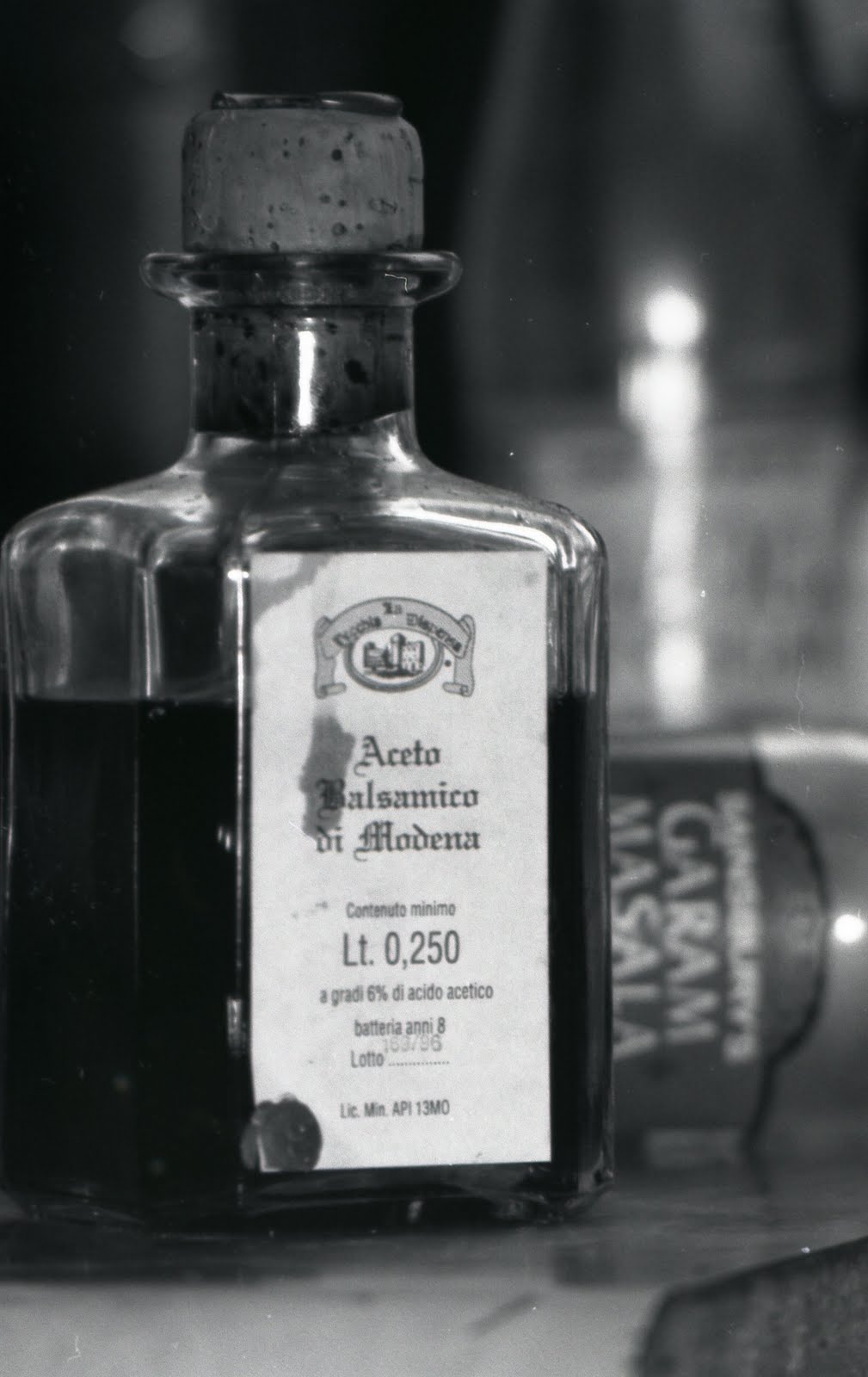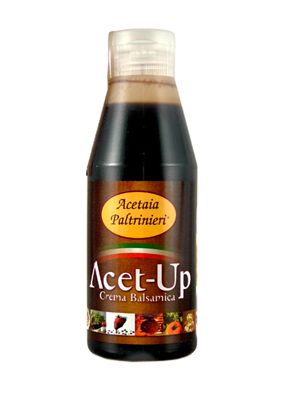There is no documented history on how balsamic vinegar was born. According to some, it all started out randomly in a kitchen household, where a certain amount of grape cooked must, the so-called Saba (which was back then used as a sweetener) was forgot in a kitchen pot and found again only after some time when the acetification/fermentation process was already taking place.

The real balsamic vinegar (not the one you can find on the supermarket shelves for a couple of bucks) is obtained from cooked grape must.
The must is matured by slow acetification derived from natural fermentation and progressive concentration through lengthy aging in a series of small barrels of different kinds of wood.

No aromatic substances are added to the must. The distinct flavor derives from the barrels’ wood.
The colour is a rich, glossy dark brown with a consistency flowing and syrupy.
The most important characteristic is the aroma that is complex and penetrating together with a pleasant and well-balanced acidity. The traditional and unique Aceto Balsamico Tradizionale flavour is a delicate, balance of sweet and sour, full-bodied and savoury with velvety undertones in complete harmony with its olfactory properties.
It is recommended with all types of dishes, from starters to desserts, directly from the bottle. It goes surprisingly well with ice cream and fruit and is the ideal companion to Parmigiano Reggiano cheese.
The taste of the real balsamic vinegar is so strong that you’ll need just one or two drops to season a big bowl of salad. So even if the price is pretty outrageous it will last you for a long time since you’ll use a really small amount every time.
The cheap versions you find in almost any supermarket around the globe is made from distilled rice vinegars to which caramel flavorings and color id industrially added.
The two products are so far away in taste that is not even possible to compare them. If you try once real balsamic vinegar you’ll never go back.
Modena’s balsamic vinegar is available in two different ageing periods:
12 YEARS minimum, labelled Affinato, with white capsule.
25 YEARS minimum, labelled Extravecchio, with gold capsule.
The price differs substantially between the two bottles and you can figure it out by yourself why.
What is Saba?
We know that balsamic vinegar derives from cooked must which is also known as Saba so let’s find out a little bit more about it.
Saba is an age-old product of Modena’s country tradition and the result of the extended cooking of the must of Trebbiano grapes alone.
One popular use for Saba is as a dressing for desserts, ranging from figs to cheeses to fresh ice cream.

It was invented as a substitute for sugar for the preparation of desserts (it contains fructose only) and was also traditionally used as a syrup. It is ideal for seasoning pumpkin tortelli and flavouring biscuits. It is also an essential ingredient of Modena’s typical Pane di Natale Christmas cake.
And finally what is ACET-UP?
And I would like to finish this article by giving you some info about an almost unknown product, also typical of the Modena region: the Acet-up.
Acet-up is a creamy balsamic vinegar sauce made exclusively from cooked grape must acetified in oak barrels for at least 4 years. It is used to flavour and decorate meat or fish dishes, boiled vegetables or risottos, and adds a special touch to fruit and ice cream. The handy squeezable
container makes it suitable for both the gourmet creations of leading chefs and speedy modern dishes.

Margherita Bisoglio
The real balsamic vinegar (not the one you can find on the supermarket shelves for a couple of bucks) is obtained from cooked grape must.
The must is matured by slow acetification derived from natural fermentation and progressive concentration through lengthy aging in a series of small barrels of different kinds of wood.
No aromatic substances are added to the must. The distinct flavor derives from the barrels’ wood.
The colour is a rich, glossy dark brown with a consistency flowing and syrupy.
The most important characteristic is the aroma that is complex and penetrating together with a pleasant and well-balanced acidity. The traditional and unique Aceto Balsamico Tradizionale flavour is a delicate, balance of sweet and sour, full-bodied and savoury with velvety undertones in complete harmony with its olfactory properties.
It is recommended with all types of dishes, from starters to desserts, directly from the bottle. It goes surprisingly well with ice cream and fruit and is the ideal companion to Parmigiano Reggiano cheese.
The taste of the real balsamic vinegar is so strong that you’ll need just one or two drops to season a big bowl of salad. So even if the price is pretty outrageous it will last you for a long time since you’ll use a really small amount every time.
The cheap versions you find in almost any supermarket around the globe is made from distilled rice vinegars to which caramel flavorings and color id industrially added.
The two products are so far away in taste that is not even possible to compare them. If you try once real balsamic vinegar you’ll never go back.
Modena’s balsamic vinegar is available in two different ageing periods:
12 YEARS minimum, labelled Affinato, with white capsule.
25 YEARS minimum, labelled Extravecchio, with gold capsule.
The price differs substantially between the two bottles and you can figure it out by yourself why.
What is Saba?
We know that balsamic vinegar derives from cooked must which is also known as Saba so let’s find out a little bit more about it.
Saba is an age-old product of Modena’s country tradition and the result of the extended cooking of the must of Trebbiano grapes alone.
One popular use for Saba is as a dressing for desserts, ranging from figs to cheeses to fresh ice cream.
It was invented as a substitute for sugar for the preparation of desserts (it contains fructose only) and was also traditionally used as a syrup. It is ideal for seasoning pumpkin tortelli and flavouring biscuits. It is also an essential ingredient of Modena’s typical Pane di Natale Christmas cake.
And finally what is ACET-UP?
And I would like to finish this article by giving you some info about an almost unknown product, also typical of the Modena region: the Acet-up.
Acet-up is a creamy balsamic vinegar sauce made exclusively from cooked grape must acetified in oak barrels for at least 4 years. It is used to flavour and decorate meat or fish dishes, boiled vegetables or risottos, and adds a special touch to fruit and ice cream. The handy squeezable
container makes it suitable for both the gourmet creations of leading chefs and speedy modern dishes.
Margherita Bisoglio



.jpg)
.jpg)

.jpg)

+Chicken+Enchilada+Casserole.jpg)
.jpg)


I was explained that the consume of this product was widespread between roman empire soldiers. Easy and pratical energy pursuit.
ReplyDelete"Yes, exactly! The Greek and then the Roman soldiers used to drink one or two spoons of fermented wine before the battle. Obviously that vinagre wasn't come from the cooking of the must of Trebbiano grapes, but others native grapes."
ReplyDeleteFrom what I know vinagre was used by monks as a relief for stomach problems and 1 tea spoon a night will regularize your intestine.
ReplyDelete"Yes, exactly, you're right!!
ReplyDeleteInfact the polyphenols in balsamic vinegar stimulate the activity of pepsin enzyme in the body. Pepsin is a digestive enzyme, which helps break proteins into smaller units (amino acids). Moreover, these polyphenols also assist the intestine in absorbing amino acids expeditiously. Efficient amino acid absorption enables the body to utilize it for cell building, repair and other body maintenance work.
Balsamic vinegar helps the digestion process and the ancient monks knew that!"